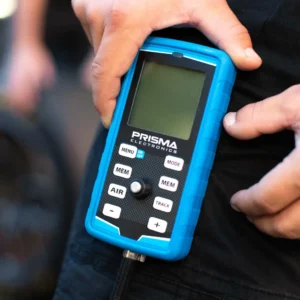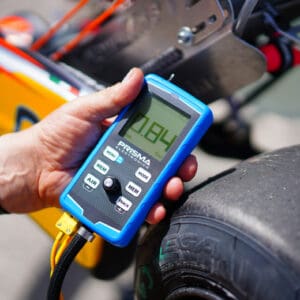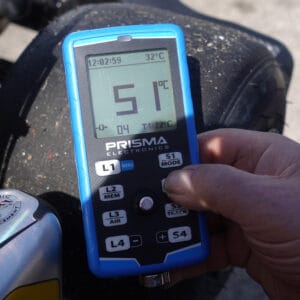Tire temperature management is a key element in motorsport that can have a significant impact on vehicle performance. As the tires are the only point of contact between the vehicle and the asphalt, it’s clear that optimizing the energy transfer during vehicle motion is essential.
One of the main questions we are often asked is: Is it more accurate to use an pyrometer with infrared sensor or one with a needle probe ?
There is no exact answer. Let’s start with the assumption that the purpose of measuring tire temperature, whether with a probe or infrared, is to evaluate the footprint of the tire on the ground, that is, how energy is distributed between the vehicle and the asphalt. As soon as the vehicle returns to the pits, this operation must be performed as quickly as possible and also as repeatable as possible . So, it is important that the method must always be the same in order to avoid different data from test to test.
It is interesting to understand what differences there were on the tires and their performance due to set-up variations or different track conditions.


In addition to evaluating energy distribution on the tread surface, temperature measurement allows us to determine if the operating range falls within the correct temperature interval. Staying within the optimal temperature range enables us to achieve the best mechanical grip and minimize performance degradation (indicated by the yellow zone in the graph).

A further clarification to be made is that when we measure the temperature as soon as the vehicle has returned to the pits, we are not measuring its absolute value, i.e. its maximum value, but the temperature which is assumed to be the average during its use. This is because the maximum values will occur in correspondence with heavy braking and its minimum will occur in correspondence with a long straight road. So what we need is primarily a repeatable method that allows us to measure temperatures as quickly as possible before the heat dissipation distorts the measurement.
We therefore want to compare the measurement with an infrared sensor or with a needle probe.
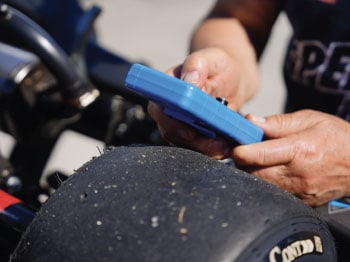
There are several theories, one of which states that the infrared sensor only measures the surface temperature and so it is incorrect. This is true, the infrared sensor measures the radiation emitted by a body, in this case the tyre, but it is also true to state that the surface temperature is influenced by the temperature of the entire compound. Assuming the surface temperature for example 100.0°C, the immediately lower layer certainly cannot be 90.0°C. Obviously there is a temperature gradient from the internal air and reaches the surface of the tread but this will not be measurable either with the infrared sensor or with the needle probe but only with simulations and/or complex calculations.
Another aspect to consider is that the infrared sensor must be PERFECTLY calibrated on the wavelength of the tyre. An infrared pyrometer that measures the temperature of a tire cannot correctly measure the temperature of a red colored surface (absolutely random example) and vice versa.
Similarly, by measuring with the needle probe with a length of 3/5 mm, we will have the measurement of the average temperature of the mixture of that portion of the volume.
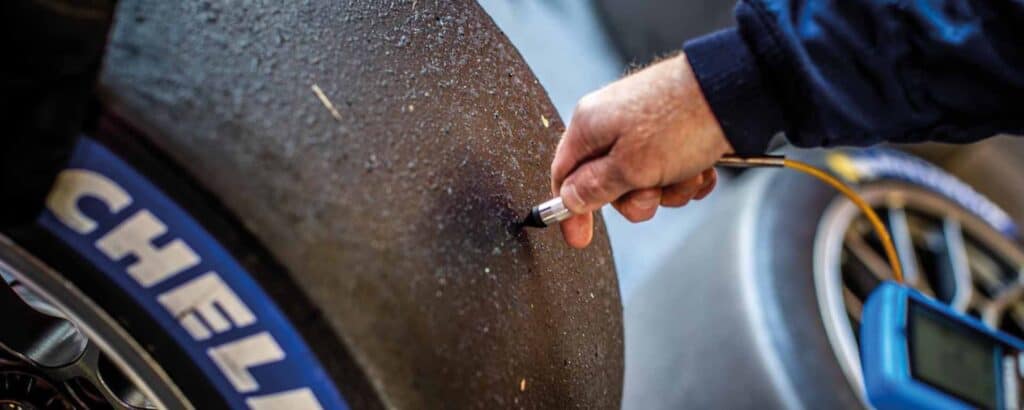
Returning to the search for our measurement method that is fast and repeatable, we understood that we mainly want to measure if we are within the correct operating temperature and how the distribution of temperature on the surface of the tread can give us an evaluation of its footprint .
At Prisma Electronics we set about doing two practical tests, both with the pyrometer with needle probe and with the infrared sensor. The instrument used is the HPM4 X + DUAL-PYR Digital Pressure Gauge with Double Pyrometer.
https://www.prismaelectronics.com/en/products/digital-pneumatic-manometer-with-double-pyrometer/
How we did the test.
- Instrument Used: HPM4X + DUAL – PYR
- https://www.prismaelectronics.com/en/products/digital-pneumatic-manometer-with-double-pyrometer/
- This instrument is a digital tire pressure gauge with a Dual Technology Pyrometer, which means it allows you to choose the method based on the measurement you want to perform.
- Two different tires:
- 13″ Pirelli tire ex Formula 1 heated with tire warmers to approximately 100°C.
- Supermoto front tire with tire warmers at around 80°C.
The tests we performed were:
- Accuracy: Do the needle probe and infrared sensor provide the same values?
- Response Speed: Which method is faster in measurement?
Below is a video of the test conducted at Prisma Electronics.
What we achieved:
Accuracy with Pirelli tire:
- Needle Probe: 105.1°C
- Infrared Sensor: 104.8°C
- Difference: 0.3°C
Accuracy with Supermoto tire:
- Needle Probe: 85.0°C
- Infrared Sensor: 85.3°C
- Difference: 0.3°C
Response Speed:
- Infrared Sensor: 27°C -> 73.5°C: Approximately 1 second maximum
- Needle Probe: 24°C -> 73.1°C: Approximately 5 seconds. This is the worst-case as the probe was at ambient temperature (24°C). From the second measurement onwards, the response speed is about 3 seconds.
The test was also carried out on a motorcycle tire to point out that, even if the measurements between the probe and the infrared are both accurate, the curved profile certainly favors the measurement with a needle probe.
So when asked which is the best tool to use, an initial answer we can give is that it also depends on the type of tyre.
In two-wheelers, where the profile of the tire is curved, it is certainly easier to use the needle probe.

For open-wheel categories, measuring with an infrared sensor allows for very fast measurements that are not affected by thermal dissipation, which would lower the temperatures. Having a pyrometer with an IR sensor + needle probe has the advantage of quickly selecting the desired method based on the tire conditions. As mentioned above, for motorcycles, there is no need for an infrared sensor, so using the needle probe directly is more suitable.

If, instead, the tread surface is uniforme, with the Infrared Sensor it is possible to have a very rapid measurement as soon as the vehicle returns to the Pit.
Having the digital pressure gauge with dual technology pyrometer therefore allows you to have the possibility to choose with which method you want to measure the temperature of the tire also based on how the tread conditions present.
As already mentioned above, if the vehicle is a motorbike, it makes no sense to have the Infrared Sensor and therefore it is better to choose directly for the needle probe.

Advantages and Disadvantages:
Measurement with Needle Probe
Advantages:
- Just insert the entire needle into the tread and wait for the temperature to stabilize.
- Possibility to measure the temperature of the compound at a depth of 3/5 mm and at specific points (e.g., areas with blistering or graining).
Disadvantages:
- To obtain the fastest measurement, the needle probes are very thin and delicate.
- Relatively slow temperature measurement, about 2.5/3 seconds in the best-case scenario for each measurement. If multiple points per tire are measured, there is a risk of reaching the last tire with dissipated temperature.
- Not very precise for measuring asphalt temperature. The probe needs to penetrate the material being measured to accurately reach the measured temperature.
Measurement with Infrared Sensor
Advantages:
- Extremely rapid response time, 0.5 seconds per reading. It is possible to quickly measure each tire without the risk of temperature dissipation.
- Wide temperature range [ 0° C – 350°C ]
- Possibility to measure the average temperature of the tread surface using the field of view (FOV). Detailed information about FOV can be found in this article: [ https://www.prismaelectronics.com/en/blog/measure-tire-temperature-infrared-pyrometer/ ]
Disadvantages:
- Measurement requires care. The infrared sensor must be correctly aimed at the surface to be measured, frontally, and at a known distance based on the point being measured. Refer to the FOV article mentioned above.
- Always keep the infrared sensor clean and periodically check for rubber debris inside it.
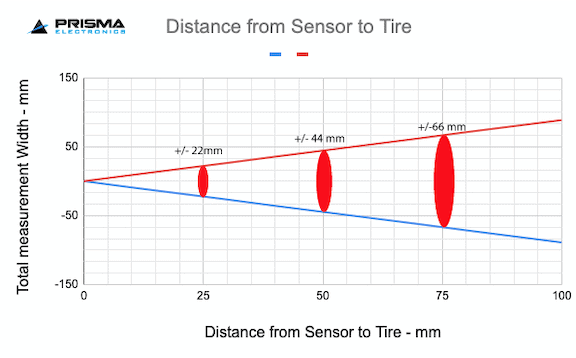

Pascal Cardinale
author
